GTP Access
This chapter provides information about GTP access.
Topics in this chapter include:
Applicability
The information and configuration in this chapter are based on SR OS Release 16.0.R3.
Overview
The GPRS Tunneling Protocol (GTP) is defined by 3GPP for carrying data through mobile backhaul networks. GTP-U (User plane) is used to forward User Equipment (UE) traffic between the Radio Access Network (RAN) and the core network. GTPv2-C (Control plane) is used within the 4G Evolved Packet Core (EPC) to establish and maintain these GTP-U tunnels. Basic Evolved Packet System (EPS) knowledge is assumed throughout this chapter.
Nokia provides Enhanced Subscriber Management (ESM) features to stationary wireless subscribers over GTP. This offers service providers the means to provide broadband services to areas that cannot be easily or sufficiently covered using traditional fixed access technologies. GTP is another type of access to the BNG, and the set of concepts applying to this context are generally referred to as fixed wireless access. In the Nokia GTP solution, the Serving Gateway (S-GW) and the Packet Data Network (PDN) Gateway (P-GW) functions are integrated with the BNG, as shown in GTP Access to the BNG.

In 3GPP architectures, specific communication channels between two entities are called interfaces. These 3GPP-defined interfaces are logical interfaces and unrelated to physical router interfaces. For example, the S11 interface covers the communication between the Mobility Management Entity (MME) and the S-GW, the S1-U interface the data path communication between the eNodeB and the S-GW, and the S5 interface the communication between the S-GW and the P-GW. The S1-MME interface covers the communication between the eNB and the MME. S11 and S1-U use GTP as their encapsulation protocol.
When a UE is activated, the UE attachment process is started, where the initial signaling passes via the eNB, the MME, and the S-GW to the P-GW to establish an EPS bearer. The EPS bearer runs from the UE via the eNB and the S-GW to the P-GW; the MME is not on the data path. Some subsequent signaling can run on the straight path from the UE to the P-GW.
The EPS bearer is a transmission path running end-to-end between a UE and a P-GW, which carries the user data; see EPS Bearer Across the Different Interfaces. The EPS bearer is the concatenation of a radio bearer on the air interface, a GTP tunnel on the S1-U interface between the eNB and the S-GW, and a GTP tunnel on the S5 interface between the S-GW and the P-GW.
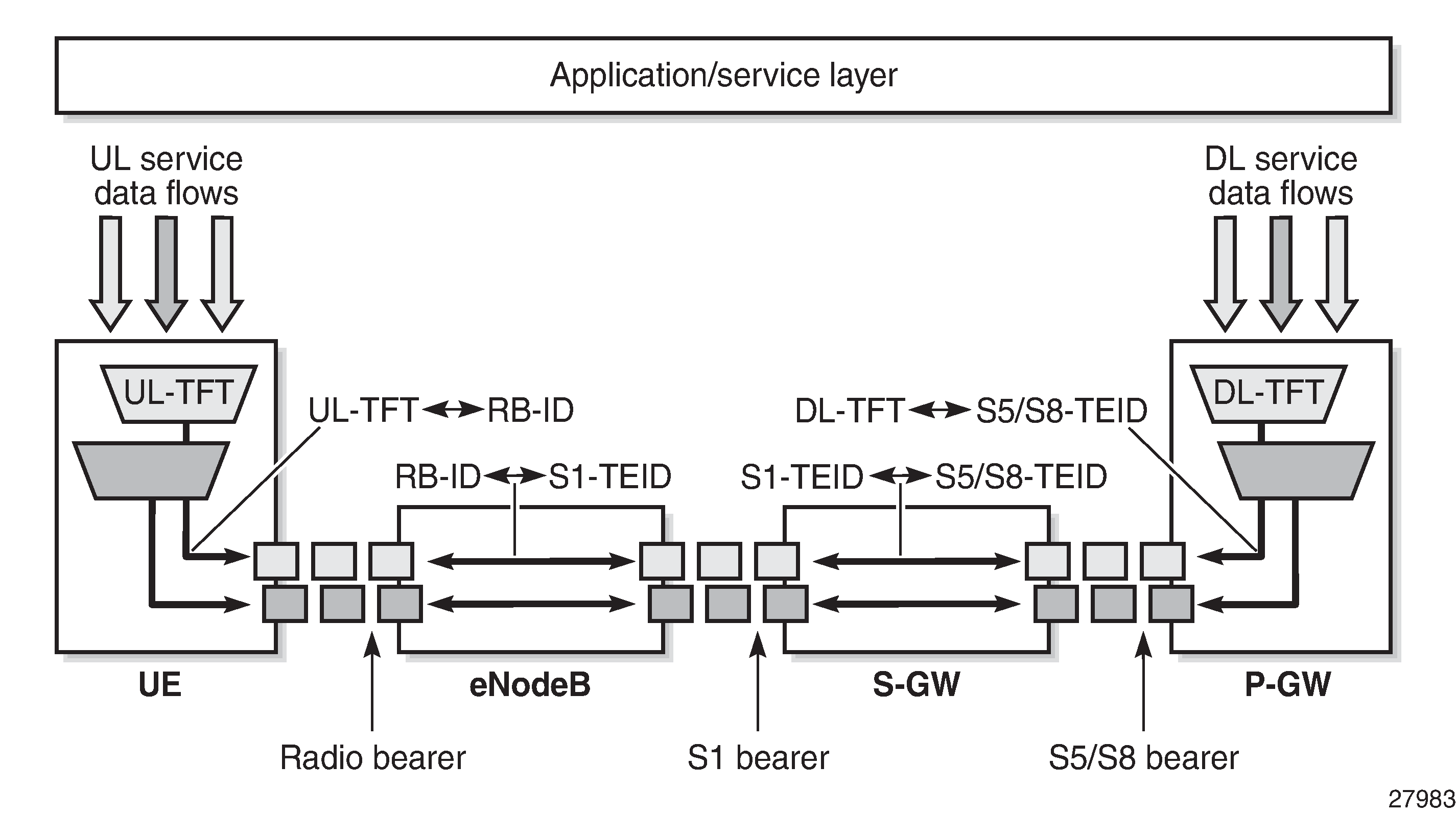
GTP-C signaling procedures are used to establish an S1 and an S5 bearer, during which Tunneling End ID (TEID) values are assigned and exchanged. These TEIDs are locally significant, and the upstream and downstream channels can have different TEIDs. With an S1 and S5 bearer established, user data can pass through using GTP-U encapsulation; see GTP-C and GTP-U Encapsulation. UDP ports 2123 and 2152 are used for GTP-C and GTP-U, respectively.
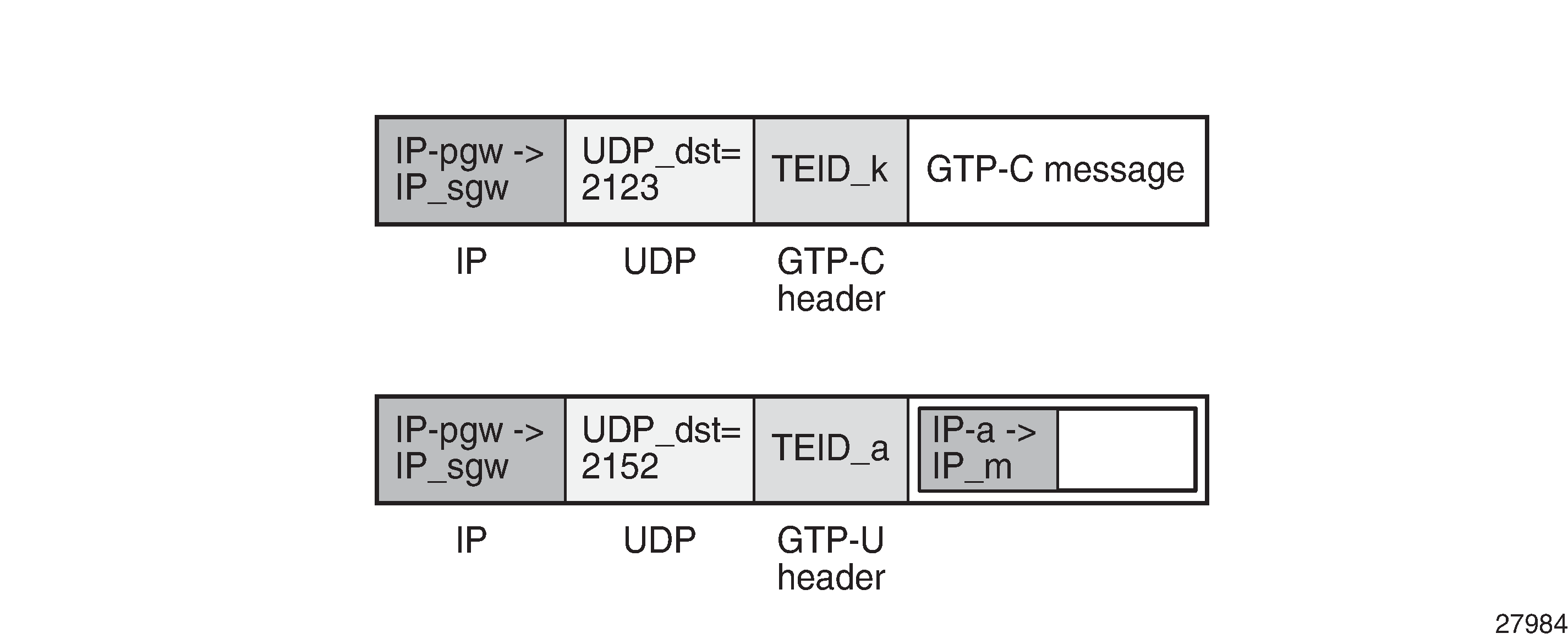
As part of the UE attachment procedure, the UE is assigned an IPv4/IPv6 address by the P-GW and a default bearer is established. The default bearer remains established throughout the lifetime of the PDN connection to provide the UE with always-on IP connectivity to that PDN. The default bearer QoS parameters can be provided by either the MME, Policy Control and Charging Rules Function (PCRF), RADIUS server, or locally.
The GTP-U tunnel encapsulation used in the network is shown in GTP-U in Up and Downstream. The IPv4/IPv6 address assigned to the UE during the attachment process is used end-to-end. For the outer header of the S1 GTP tunnel, the eNB and the S-GW IPv4 addresses are used. Similarly, for the S5 GTP tunnel, the S-GW and P-GW IPv4 addresses are used.
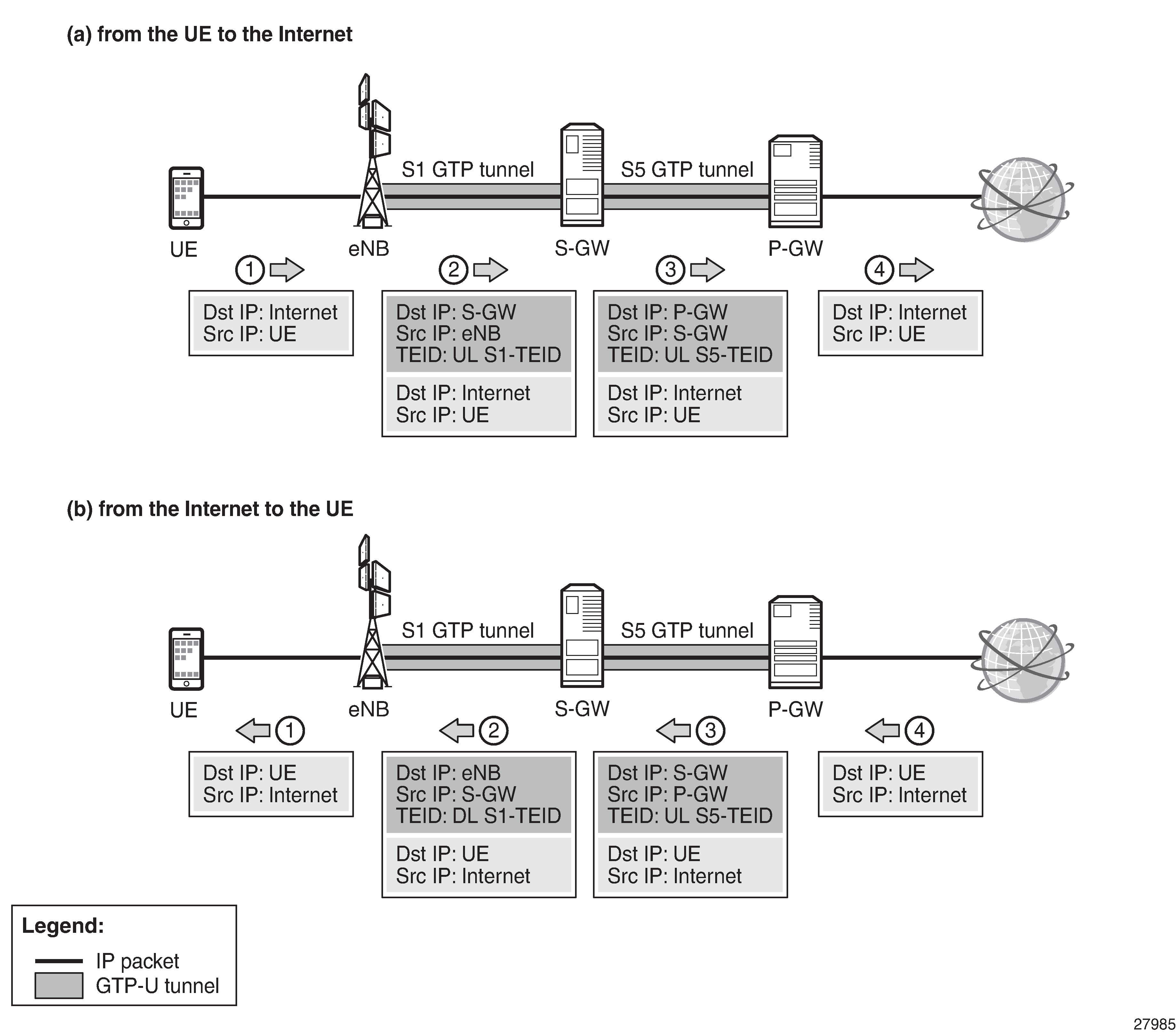
Because the S-GW and P-GW functionalities are integrated with the BNG, the S5 logical interface is internal to the system. SR OS supports TPSDA over GTP access tunnels initiated over the S11 (GTPv2-C) interface, where the UE data traffic is on the S1-U (GTP-U) interface. This is sometimes referred to as ESM over GTP (ESMoGTP).
Both IPv4 and IPv6 connectivity over GTP is supported. GTP session authentication can be performed using LUDB, RADIUS, or NASREQ.
ESMoGTP requires PXC FPE in order to support L3 re-routing in the access network and in-line encapsulation/decapsulation of the GTP protocol.
GTP-C Control - GTP Host Creation and Host Deletion
GTP-C Control - GTP Host Creation shows the steps used for creating a GTP host.
A GTP S11 interface must be created and enabled for the BNG to accept and process the Create Session Request message emitted by the MME. This message includes IMSI, IMEI, MS-ISDN, APN, QCI, and so on.
The APN received is mapped via the APN policy to an authentication method (RADIUS, LUDB, or NASREQ), and to an optional default service and group interface. Also, a peer profile can be applied to that interface, defining keepalive timer (KA), default GTP Information Elements (IEs), Python-derived policies, and so on.
By default, the IMSI is used for authentication toward AAA.
The Access Accept message sent by AAA returns the standard set of ESM parameters, such as the IP address, QoS overrides, service ID, and group interface where the GTP host must be created.
The Create Session response includes the locally assigned TEID, IPv4/IPv6 information, AMBR, QCI, and the S1-U TEID and the S1-U endpoint. The GTP host is created.
The MME sends a Modify Bearer Request Message to update the default bearer information with the eNB final information (IP, TEID, and so on).
The BNG starts a keep-alive timer per S11 peer, using the timer values defined by the peer profile. Also, the MME can start a keep-alive timer, independent from the BNG.

GTP-C Control - GTP Host Deletion shows the actions taken for deleting a GTP host when triggered by a Delete Session Request message sent by the MME: on an incoming Delete Session Request message, the ESM host termination process is executed, and a Delete Session Response message is sent to the MME. This is marked as event 1 in GTP-C Control - GTP Host Deletion.
However, the BNG can also delete GTP hosts because of the echo timers expiring.
The BNG can autonomously start the GTP host deletion process, including the deletion of the GTP session; for example, when idle timers expire. The MME is notified through the Delete Bearer Request message so that it can delete the default bearer for the UE specified.

Configuration
GTP Access Topology shows the topology used for demonstrating GTP Access.
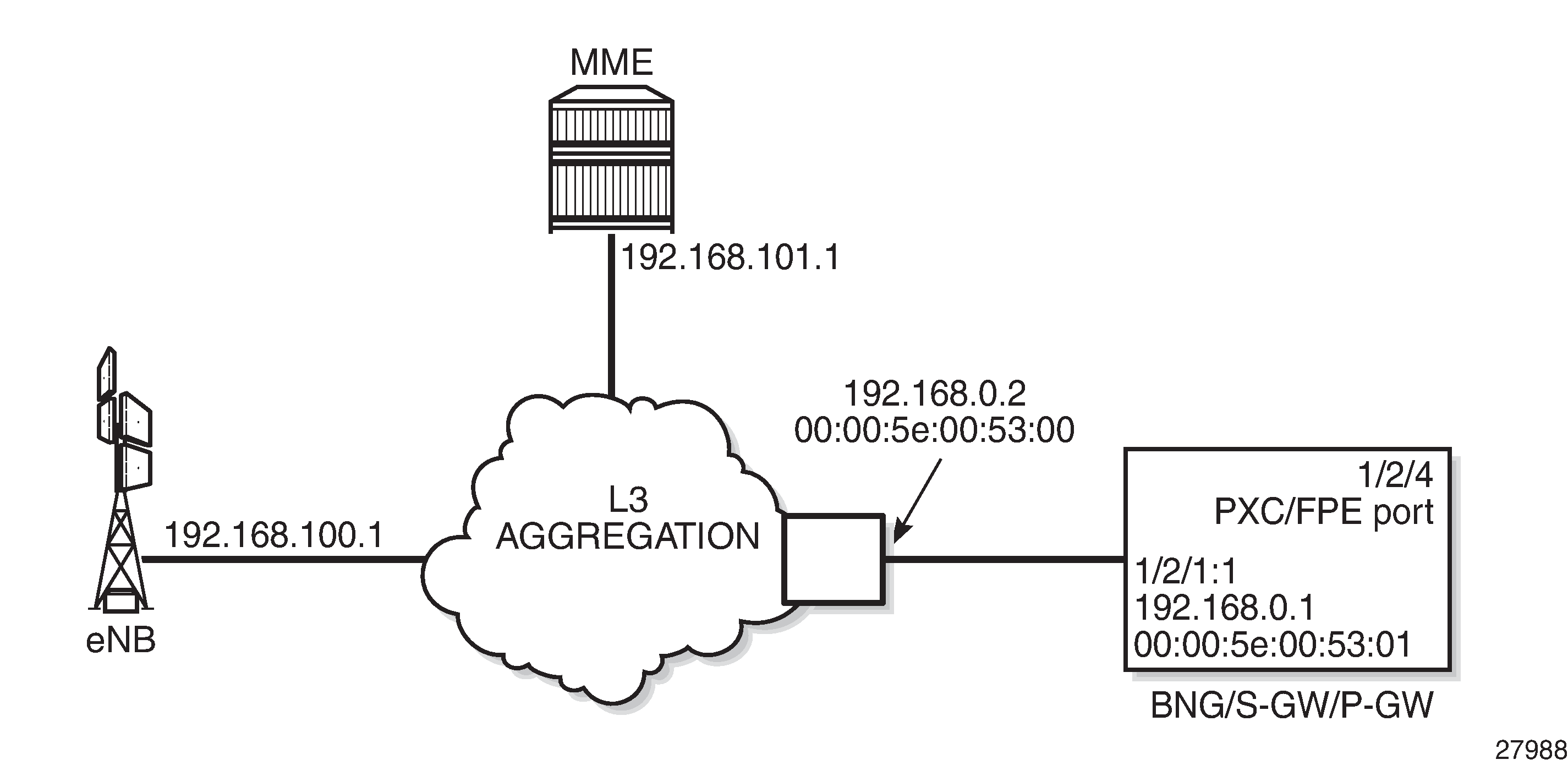
On the BNG, the traffic entering on port 1/2/1 is internally routed to port 1/2/4, which is configured as a PXC port; see 7450 ESS, 7750 SR, and 7950 XRS Advanced Configuration Guide - Part I , the Port Cross-Connect (PXC) chapter for more information. The PXC port 1/2/4 additionally requires subscriber management extensions to be enabled in the forwarding plane (FPE), see 7450 ESS, 7750 SR, and 7950 XRS Advanced Configuration Guide - Part II , the VXLAN Forwarding Path Extension chapter, and the encap-type is set to qinq:
# on BNG-1
configure
port 1/2/1
ethernet
mode access
encap-type dot1q
exit
no shutdown
exit
port 1/2/4
ethernet
mode hybrid
encap-type dot1q
exit
no shutdown
exit
port-xc
pxc 1 create
port 1/2/4
no shutdown
exit
exit
port-xc
pxc 1 create
port 1/2/4
no shutdown
exit
exit
port pxc-1.a
ethernet
encap-type qinq
exit
no shutdown
exit
port pxc-1.b
ethernet
encap-type qinq
exit
no shutdown
exit
exit
configure
fwd-path-ext
fpe 1 create
path pxc 1
sub-mgmt-extensions
exit
exit
exit
The status of the PXC port can be verified as follows:
*A:BNG-1# show port-xc
===============================================================================
Port Cross-Connect Information
===============================================================================
PXC Admin Oper Port Description
Id State State Id
-------------------------------------------------------------------------------
1 Up Up 1/2/4 (Not Specified)
-------------------------------------------------------------------------------
No. of PXCs: 1
===============================================================================
*A:BNG-1#
With subscriber management extensions enabled, SR OS can dynamically create SAPs on which GTP subscribers can be terminated at a later stage. The status for FPE 1 shows that the subscriber management extensions are enabled, as follows. The operational state indicated as N/A at the end of the same line is not relevant.
*A:BNG-1# show fwd-path-ext fpe 1
===============================================================================
FPE Id: 1
===============================================================================
Description : (Not Specified)
Path : pxc 1
Pw Port : Disabled Oper : down
Sub Mgmt Extension : Enabled Oper : N/A
Vxlan Termination : Disabled Oper : down
===============================================================================
*A:BNG-1#
The APN policy pol-APN-ACG is defined in the subscriber management gtp context, as follows. The other profiles are required for ESM host and subscriber setup.
configure
subscriber-mgmt
gtp
apn-policy "pol-APN-ACG" create
apn acg.mnc001.mcc001.gprs create
user-db "ludb-GTP"
exit
exit
exit
sla-profile "sla-prof-1" create
exit
sub-profile "sub-prof-1" create
exit
sub-ident-policy "sub-id-pol-direct" create
sub-profile-map
use-direct-map-as-default
exit
sla-profile-map
use-direct-map-as-default
exit
exit
exit
exit
Two services are used to provide GTP access to the BNG, as shown in GTP Tunnel and Subscriber Termination Configuration Logic. The first routed service provides the GTP tunnel termination, and the second provides the infrastructure to terminate the GTP subscribers.
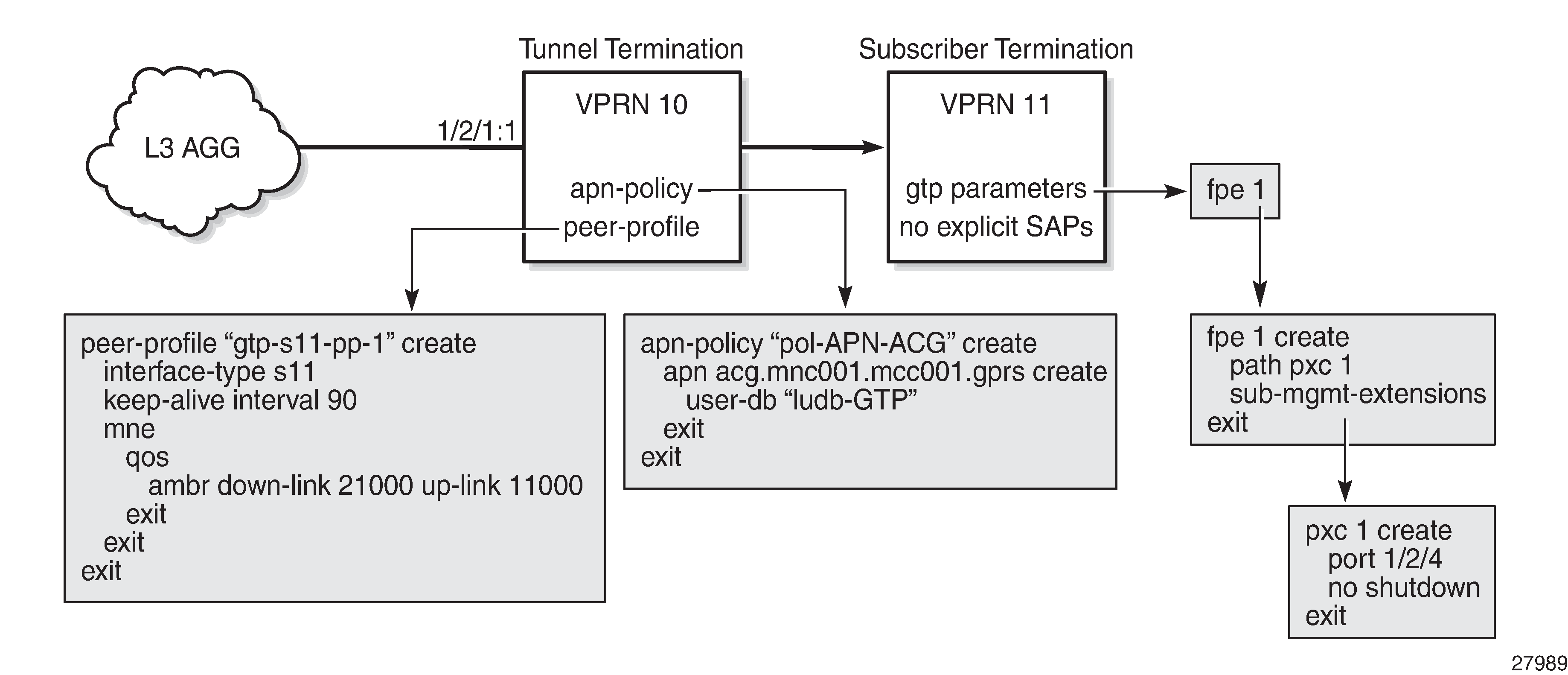
GTP Tunnel Terminating VPRN
In GTP Tunnel and Subscriber Termination Configuration Logic, VPRN 10 implements the GTP tunnel termination. The GTP traffic enters VPRN 10 on interface int-BNG-L3AGG with MAC address 00:00:5e:00:53:01 on SAP 1/2/1:1. The interface int-GTP-endpoint is defined as a loopback interface, potentially providing redundancy to the L3 aggregation network. Static routes and a static ARP entry are defined in VPRN 10 for reaching the MME and the eNB through the L3 aggregation network, providing control over the L3 aggregation test environment. The APN policy provides the link between the tunnel termination VPRN (10) and the subscriber terminating VPRN (11). The peer-profile map defines which peer profile is used for which MME. In this example, the APN policy is pol-APN-ACG, and the peer profile is gtp-s11-pp-1. VPRN 10 is configured as follows:
configure
service
vprn 10 name "GTP-tunnel-termination" customer 1 create
description "GTP Tunnel termination"
route-distinguisher 64496:10
interface "int-GTP-endpoint" create
description "Tunnel endpoint IP"
address 192.0.2.10/32
loopback
exit
interface "int-BNG-L3AGG" create
address 192.168.0.1/24
mac 00:00:5e:00:53:01
static-arp 192.168.0.2 00:00:5e:00:53:00
sap 1/2/1:1 create
exit
exit
static-route-entry 192.168.100.0/24
next-hop 192.168.0.2
no shutdown
exit
exit
static-route-entry 192.168.101.0/24
next-hop 192.168.0.2
no shutdown
exit
exit
gtp
s11
interface "int-GTP-endpoint" create
apn-policy "pol-APN-ACG"
exit
peer-profile-map
address 192.168.100.1/32 peer-profile "gtp-s11-pp-1"
exit
exit
exit
no shutdown
exit
exit
exit
Peer Profile
A peer-profile policy controls the keep-alive interval, and the QoS configuration to be used for MMEs (AMBR, ARP, QCI, …). The peer profile gtp-s11-pp-1 used for the example shown in Figure 8 is defined as follows. AMBR downlink and uplink are set to 21000 kb/s and 11000 kb/s, respectively, and QCI is set to 8.
configure
subscriber-mgmt
gtp
peer-profile "gtp-s11-pp-1" create
interface-type s11
keep-alive interval 90
mme
qos
ambr down-link 21000 up-link 11000
arp 1
down-link gbr 0 mbr 0
qci 8
up-link gbr 0 mbr 0
exit
exit
exit
exit
exit
exit
APN Policy
An APN policy controls the authentication method per APN (LUDB, RADIUS, or Diameter). The APN policy pol-APN-ACG used for the example shown in GTP Tunnel and Subscriber Termination Configuration Logic is defined as follows. Only one APN is defined (acg.mnc001.mcc001.gprs), and the UEs using this APN are authenticated through the ludb-GTP LUDB.
configure
subscriber-mgmt
gtp
apn-policy "pol-APN-ACG" create
apn acg.mnc001.mcc001.gprs create
user-db "ludb-GTP"
exit
exit
exit
exit
exit
For authenticating GTP users using an LUDB, the LUDB must define hosts in the IPoE section of the LUDB. In this example, host matching is based on the IMSI, which is automatically populated in the IPoE string match criterion. Therefore, the match-list string command is used, but matching can also be based on a Derived ID provided by a Python script. Individual hosts can be matched using the string command for host-identification. To avoid the definition of many hosts, a default host can be used. In both cases, the output provides the service and the interface where the GTP subscriber must be implemented, as well as the IPv4/IPv6 address information required for the Local Address Assignment (LAA), as follows:
configure
subscriber-mgmt
local-user-db "ludb-GTP" create
ipoe
match-list string
host "host-1" create
host-identification
string "001020000000111"
exit
address pool "pool4-1"
identification-strings 254 create
subscriber-id "GTP-subscriber-111"
sla-profile-string "sla-prof-1"
sub-profile-string "sub-prof-1"
exit
interface "int-GRP" service-id 11
ipv6-slaac-prefix-pool "pool6-1"
no shutdown
exit
host "default" create
address pool "pool4-1"
interface "int-GRP" service-id 11
ipv6-slaac-prefix-pool "pool6-1"
no shutdown
exit
exit
no shutdown
exit
exit
exit
GTP Subscriber Terminating VPRN
In GTP Access Topology, VPRN 11 implements the GTP subscriber termination. Because GTP subscribers are ESM subscribers, the regular ESM concepts apply, meaning that subscriber management profiles are required; however, no explicit SAP definitions are required. LAA is used, where server lcl-DHCPs-ip4 is used for IPv4, and lcl-DHCPs-ip6 is used for IPv6. To support SLAAC, the IPv6 router-advertisements context has prefix-options autonomous enabled. The gtp-parameters context in the group interface defines the FPE to be used and must be enabled (no shutdown), as follows:
configure
service
vprn 11 name "GTP-subsc-termination" customer 1 create
description "GTP subscriber termination"
---snip---
route-distinguisher 64496:11
subscriber-interface "int-SUSBC" create
address 192.168.50.1/24
ipv6
delegated-prefix-len 56
subscriber-prefixes
prefix 2001:db8:101::/48 wan-host
exit
exit
group-interface "int-GRP" gtp create
gtp-parameters
fpe 1
no shutdown
exit
ipv6
router-advertisements
prefix-options
autonomous
exit
no shutdown
exit
exit
local-address-assignment
server "lcl-DHCPs-ip4"
client-application ipoe-v4
ipv6
client-application ipoe-slaac
server "lcl-DHCPs-ip6"
exit
no shutdown
exit
sap-parameters
sub-sla-mgmt
def-sla-profile "sla-prof-1"
def-sub-profile "sub-prof-1"
sub-ident-policy "sub-id-pol-direct"
exit
exit
exit
exit
no shutdown
exit
exit
exit
Enabling the gtp-parameters context (no shutdown) results in SR OS creating SAP pxc-1.b:1.8, as follows. The square brackets indicate that the SAP is created automatically, without any explicit configuration.
*A:BNG-1# show service id 11 sap
===============================================================================
SAP(Summary), Service 11
===============================================================================
PortId SvcId Ing. Ing. Egr. Egr. Adm Opr
QoS Fltr QoS Fltr
-------------------------------------------------------------------------------
[pxc-1.b:1.8] 11 1 none 1 none Up Up
-------------------------------------------------------------------------------
Number of SAPs : 1
-------------------------------------------------------------------------------
===============================================================================
*A:BNG-1#
When the UE with IMSI 001020000000111 connects, an S11 session is created, as follows. The 00:03:ff:f0:01:20 MAC address and pxc-1.b:1.8 SAP are internally generated to link the GTP session with an ESM IPoE session. The remote S1-U address is 192.168.101.1 for Bearer 6. The locally and remotely assigned TEID values are also shown.
*A:BNG-1# show subscriber-mgmt gtp s11 session imsi 001020000000111
===============================================================================
GTP S11 sessions
===============================================================================
IMSI : 001020000000111
APN : acg.mnc001.mcc001.gprs
-------------------------------------------------------------------------------
Peer router : 10
Peer address : 192.168.100.1
Remote control TEID : 22
Local control TEID : 4293919008
PDN TEID : 4293919008
Charging characteristics : (None)
Uplink AMBR (kbps) : 10000
Downlink AMBR (kbps) : 20000
Ipoe-session SAP : [pxc-1.b:1.8]
Ipoe-session Mac Address : 00:03:ff:f0:01:20
Bearer 6
Rem S1-U address : 192.168.101.1
rem TEID : 22
loc TEID : 4293919014
uplink GBR (kbps) : 0
uplink MBR (kbps) : 0
downlink GBR (kbps) : 0
downlink MBR (kbps) : 0
QoS Class ID : 8
alloc/ret priority : 1
-------------------------------------------------------------------------------
No. of GTP S11 sessions: 1
===============================================================================
*A:BNG-1#
Additionally, an ESM subscriber and an IPoE session is created on SAP pxc-1.b:1.8, as follows. The subscriber identifier is taken from the LUDB (GTP-subscriber-111). The IPoE session is created on service 11 and uses the internally generated MAC address. The IPv4 and the IPv6 addresses are combined in the same IPoE session, with MAC address 00:03:ff:e0:01:20.
*A:BNG-1# show service active-subscribers hierarchy
===============================================================================
Active Subscribers Hierarchy
===============================================================================
-- 001020000000111 (sub-prof-1)
|
+-- sap:[pxc-1.b:1.8] - sla:sla-prof-1
|
+-- IPOE-session - mac:00:03:ff:e0:01:20 - svc:11
|
|-- 192.168.50.12 - GTP
|
+-- 2001:db8:101:1::/64 - GTP
-------------------------------------------------------------------------------
Number of active subscribers : 1
Flags: (N) = the host or the managed route is in non-forwarding state
===============================================================================
*A:BNG-1#
Because an IPv4 address and an IPv6 address is used, two subscriber hosts are created on VPRN 11, as follows:
*A:BNG-1# show service id 11 subscriber-hosts
=============================================================
Subscriber Host table
=============================================================
Sap Subscriber
IP Address
MAC Address PPPoE-SID Origin Fwding State
-------------------------------------------------------------
[pxc-1.b:1.8] 001020000000111
192.168.50.12
00:03:ff:e0:01:20 N/A GTP Fwding
[pxc-1.b:1.8] 001020000000111
2001:db8:101:1::/64
00:03:ff:e0:01:20 N/A GTP Fwding
-------------------------------------------------------------
Number of subscriber hosts : 2
=============================================================
*A:BNG-1#
With two UEs connected to the BNG, the IPv4 and IPv6 addresses present in the routing tables are as follows. The addresses assigned to the UE that attached first are shown in bold.
*A:BNG-1# show router 11 route-table ipv4
===============================================================================
Route Table (Service: 11)
===============================================================================
Dest Prefix[Flags] Type Proto Age Pref
Next Hop[Interface Name] Metric
-------------------------------------------------------------------------------
192.168.50.0/24 Local Local 21h22m33s 0
int-SUSBC 0
192.168.50.12/32 Remote Sub Mgmt 00h28m52s 0
[int-GRP] 0
192.168.50.13/32 Remote Sub Mgmt 00h01m13s 0
[int-GRP] 0
-------------------------------------------------------------------------------
No. of Routes: 3
Flags: n = Number of times nexthop is repeated
B = BGP backup route available
L = LFA nexthop available
S = Sticky ECMP requested
===============================================================================
*A:BNG-1#
*A:BNG-1# show router 11 route-table ipv6
===============================================================================
IPv6 Route Table (Service: 11)
===============================================================================
Dest Prefix[Flags] Type Proto Age Pref
Next Hop[Interface Name] Metric
-------------------------------------------------------------------------------
2001:db8:101::/48 Local Local 21h23m02s 0
int-SUSBC 0
2001:db8:101:1::/64 Remote Sub Mgmt 00h29m21s 0
[int-GRP] 0
2001:db8:101:2::/64 Remote Sub Mgmt 00h01m42s 0
[int-GRP] 0
-------------------------------------------------------------------------------
No. of Routes: 3
Flags: n = Number of times nexthop is repeated
B = BGP backup route available
L = LFA nexthop available
S = Sticky ECMP requested
===============================================================================
*A:BNG-1#
Debug
Debugging is useful when troubleshooting GTP scenarios. The debug configuration used is as follows:
debug
router service-name "GTP-subsc-termination"
ip
dhcp
detail-level high
mode egr-ingr-and-dropped
exit
exit
local-dhcp-server "lcl-DHCPs-ip4"
detail-level high
mode egr-ingr-and-dropped
exit
exit
subscriber-mgmt
local-user-db "ludb-GTP"
detail all
exit
exit
gtp
event
packet
detail-level high
mode all
exit
exit
exit
The trace for the UE with IMSI 001020000000111 initiating a connection to APN acg.mnc001.mcc001.gprs is as follows; also see GTP-C Control - GTP Host Creation. Step 1 is the Create Session request, with the parameters supplied by the test-tool (IMSI, APN, RAT TYPE, PDN TYPE, and so on). Step 9 indicates that a GTP downlink is created. Step 12 indicates that the LUDB is accessed successfully. Steps 13, 14, and 15 indicate that LAA is used for address assignment. Step 28 indicates that an S1-U session is successfully established.
*A:BNG-1# show log log-id 1 ascending
===============================================================================
Event Log 1
===============================================================================
Description : (Not Specified)
Memory Log contents [size=100 next event=31 (not wrapped)]
1 2018/09/18 10:39:53.567 CEST MINOR: DEBUG #2001 vprn10 GTP
"GTP: GTPv2_INGRESS
IP Hdr: Src: 192.168.100.1, Dst: 192.0.2.10, Len: 205
UDP Hdr: Src: 2123, Dst: 2123, Len: 185
GTPv2 Hdr: Len: 173, Seq: 105, TEID: 0x0
GTPv2_INGRESS| S11-C: 192.168.100.1 | Rx: Create Session Req
[IMSI] : 001020000000111
[APN] : acg.mnc001.mcc001.gprs
[RAT TYPE] : EUTRAN
[CSID] : inst: 0 Len: 7 Val: 01010203040102
[PDN TYPE] : IPv4v6
[INDICATION] : GTP DAF
[S11 MME-C F-TEID] : 0x00000028 IPv4: 192.168.100.1
[BEARER CXT] : Add :0x6
Bearer Qos: PVI: 0x00 PL: 0x0f PCI: 0x00 QCI: 0x09
MBR: UL: 1000 kbps, DL: 1000 kbps GMBR: UL: 0 kbps, DL: 0 kbps
[RECOVERY] : 1
[PROTO CFG OPTS] : 0x80 (PPP_USE_IPPDP)
IPCP_PROTO_ID: REQ
PRIDNS : 0.0.0.0
PRINBNS: 0.0.0.0
SECDNS : 0.0.0.0
SECNBNS: 0.0.0.0
DNSv6_CONT_ID:REQ
PCSCF_CONT_ID:REQ
IPV4_LINK_MTU:REQ "
2 2018/09/18 10:39:53.567 CEST MINOR: DEBUG #2001 Base GTP
"GTP: GTP_USER_CREATED
imsi = 001020000000111 imei = 0000000000000000
msIsdn = 0000000000000000
bssid = 0:0:0:0:0:0
ssid =
uli = 0 0 0 0 0 0 0 0 0 0 0 0 0
"
3 2018/09/18 10:39:53.567 CEST MINOR: DEBUG #2001 Base GTP
"GTP: GTP_ADD_DOWNLINK_TO_USER
imsi = 001020000000111 imei = 0000000000000000
msIsdn = 0000000000000000
bssid = 0:0:0:0:0:0
ssid =
uli = 0 0 0 0 0 0 0 0 0 0 0 0 0
"
4 2018/09/18 10:39:53.567 CEST MINOR: DEBUG #2001 Base GTP
"GTP: GTP_PEER_CREATED
peer = {2, 192.168.100.1, 2123} ver 2 laddr 192.0.2.10
"
5 2018/09/18 10:39:53.567 CEST MINOR: DEBUG #2001 Base GTP
"GTP: GTP_ADD_DOWNLINK_TO_PEER
peer = {2, 192.168.100.1, 2123} ver 2 laddr 192.0.2.10
"
6 2018/09/18 10:39:53.567 CEST MINOR: DEBUG #2001 vprn10 GTP
"GTP: PEER ADDED
peer = 192.168.100.1 peer port = 2123 src = 192.0.2.10
Gtpv2 restartcnt = 1 path mgmt state = disabled
ka retry cnt= 0
"
7 2018/09/18 10:39:53.567 CEST MINOR: DEBUG #2001 Base GTP
"GTP: RETRANSMIT_CTXT_ALLOCATED
type Create Session Resp peer {2, 192.168.100.1, 2123} seqnr 105
"
8 2018/09/18 10:39:53.567 CEST MINOR: DEBUG #2001 vprn10 GTP
"GTP: PEER PATH MGMT ENABLED
peer = 192.168.100.1 peer port = 2123 src = 192.0.2.10
Gtpv2 restartcnt = 1 path mgmt state = up
ka retry cnt= 0
"
9 2018/09/18 10:39:53.567 CEST MINOR: DEBUG #2001 vprn10 GTP
"GTP: GTP_DOWNLINK_CREATED
gtp proto=GTP
gtp iftype=S11
loc s11 teid=0
rem s11 teid=28
s5 teid=0
pdn type=0
pdn v4 address=::
pdn v6 address=::
vrf=2
ingIfIndex=3
gtp-c src ip=192.0.2.10
gtp-c dst ip=192.168.100.1
gtp-u src ip=192.0.2.10
gtp-u dst ip=::
chargChar=0
dnLkAMBR=0
upLkAMBR=0
debug flag=1
imei none
msIsdn none
def bearerId=0
"
10 2018/09/18 10:39:53.567 CEST MINOR: DEBUG #2001 Base GTP
"GTP: BEARER_CTXT_ALLOCATED
imsi = 001020000000111 apn = acg.mnc001.mcc001.gprs
id = 6
"
11 2018/09/18 10:39:53.567 CEST MINOR: DEBUG #2001 Base GTP
"GTP: GTP_ADD_BEARER_TO_RX_CTXT
type Create Session Resp peer {2, 192.168.100.1, 2123} seqnr 105
"
12 2018/09/18 10:39:53.567 CEST MINOR: DEBUG #2001 Base LUDB
"LUDB: User lookup success - host found
string:
original: 001020000000111
masked: 001020000000111
Host host-1 found in user data base ludb-GTP"
13 2018/09/18 10:39:53.568 CEST MINOR: DEBUG #2001 vprn11 DHCP server
"DHCP server: lcl-DHCPs-ip4
Rx internal <NULL>
ciaddr : 0.0.0.0
"
14 2018/09/18 10:39:53.568 CEST MINOR: DEBUG #2001 vprn11 DHCP server
"DHCP server: lcl-DHCPs-ip4
lease added for 192.168.50.15 state=internalOffered
"
15 2018/09/18 10:39:53.568 CEST MINOR: DEBUG #2001 vprn11 DHCP server
"DHCP server: lcl-DHCPs-ip4
lease update for 192.168.50.15 state=internal
"
16 2018/09/18 10:39:53.570 CEST MINOR: DEBUG #2001 Base GTP
"GTP: GTP_REMOVE_BEARER_FROM_RX_CTXT
type Create Session Resp peer {2, 192.168.100.1, 2123} seqnr 105
"
17 2018/09/18 10:39:53.570 CEST MINOR: DEBUG #2001 Base GTP
"GTP: RETRANSMIT_CTXT_UPDATED
type Create Session Resp peer {2, 192.168.100.1, 2123} seqnr 105
"
18 2018/09/18 10:39:53.570 CEST MINOR: DEBUG #2001 vprn10 GTP
"GTP: GTPv2_EGRESS
IP Hdr: Src: 192.0.2.10, Dst: 192.168.100.1, Len: 228
UDP Hdr: Src: 2123, Dst: 2123, Len: 208
GTPv2 Hdr: Len: 196, Seq: 105, TEID: 0x28
I:*** | A:*** | S11-C: 192.0.2.10 | Tx: Create Session Resp
[CAUSE] : SUCCESS
[RECOVERY] : 6
[PROTO CFG OPTS] : 0x80 (PPP_USE_IPPDP)
IPCP_PROTO_ID: REJ
PRIDNS : 0.0.0.0
PRINBNS: 0.0.0.0
SECDNS : 0.0.0.0
SECNBNS: 0.0.0.0
IPV4_LINK_MTU: 1400
[S11/S4-C SGW F-TEID] : 0xffb00120 IPv4: 192.0.2.10
[S5/S8-C PGW F-TEID] : 0xffb00120 IPv4: 192.0.2.10
[APN RESTRICTION] : No Context/Restriction
[PDN ADDR ALLOC] : IPv4v6 192.168.50.15 2001:db8:101:2:17:ffff:fe00:1/64
[AMBR] : UL: 11000 kbps, DL: 21000 kbps
[BEARER CXT] : Add :0x6 Cause: SUCCESS
Bearer Qos: PVI: 0x00 PL: 0x01 PCI: 0x00 QCI: 0x08
MBR: UL: 0 kbps, DL: 0 kbps GMBR: UL: 0 kbps, DL: 0 kbps
[S1-U SGW F-TEID] : 0xffb00126 IPv4: 192.0.2.10
[S5/S8-U PGW F-TEID] : 0xffb00126 IPv4: 192.0.2.10"
19 2018/09/18 10:39:53.570 CEST MINOR: DEBUG #2001 vprn10 GTP
"GTP: GTP_ACCESS_ACCEPT
gtp proto=GTP
gtp iftype=S11
loc s11 teid=ffb00120
rem s11 teid=28
s5 teid=ffb00120
pdn type=3
pdn v4 address=192.168.50.15
pdn v6 address=2001:db8:101:2:17:ffff:fe00:1
vrf=2
ingIfIndex=3
gtp-c src ip=192.0.2.10
gtp-c dst ip=192.168.100.1
gtp-u src ip=192.0.2.10
gtp-u dst ip=0.0.0.0
chargChar=0
dnLkAMBR=21000
upLkAMBR=11000
debug flag=1
imei none
msIsdn none
def bearerId=6
"
20 2018/09/18 10:39:53.592 CEST MINOR: DEBUG #2001 vprn10 GTP
"GTP: GTPv2_INGRESS
IP Hdr: Src: 192.168.100.1, Dst: 192.0.2.10, Len: 62
UDP Hdr: Src: 2123, Dst: 2123, Len: 42
GTPv2 Hdr: Len: 30, Seq: 106, TEID: 0xffb00120
GTPv2_INGRESS| S11-C: 192.168.100.1 | Rx: Modify Bearer Req
[BEARER CXT] : Add :0x6
[S1-U eNB F-TEID] : 0x00000028 IPv4: 192.168.101.1"
21 2018/09/18 10:39:53.592 CEST MINOR: DEBUG #2001 vprn10 GTP
"GTP: GTP_DOWNLINK_IN_SESSION_MSG_REVD
gtp proto=GTP
gtp iftype=S11
loc s11 teid=ffb00120
rem s11 teid=28
s5 teid=ffb00120
pdn type=3
pdn v4 address=192.168.50.15
pdn v6 address=2001:db8:101:2:17:ffff:fe00:1
vrf=2
ingIfIndex=3
gtp-c src ip=192.0.2.10
gtp-c dst ip=192.168.100.1
gtp-u src ip=192.0.2.10
gtp-u dst ip=0.0.0.0
chargChar=0
dnLkAMBR=21000
upLkAMBR=11000
debug flag=1
imei none
msIsdn none
def bearerId=6
Gtpv2 Modify Bearer Req
"
22 2018/09/18 10:39:53.592 CEST MINOR: DEBUG #2001 Base GTP
"GTP: RETRANSMIT_CTXT_ALLOCATED
type Modify Bearer Resp peer {2, 192.168.100.1, 2123} seqnr 106
"
23 2018/09/18 10:39:53.592 CEST MINOR: DEBUG #2001 Base GTP
"GTP: GTP_ADD_BEARER_TO_RX_CTXT
type Modify Bearer Resp peer {2, 192.168.100.1, 2123} seqnr 106
"
24 2018/09/18 10:39:53.593 CEST MINOR: DEBUG #2001 vprn10 GTP
"GTP: GTP_REMOVE_BEARER_FROM_DOWNLINK
gtp proto=GTP
gtp iftype=S11
loc s11 teid=ffb00120
rem s11 teid=28
s5 teid=ffb00120
pdn type=3
pdn v4 address=192.168.50.15
pdn v6 address=2001:db8:101:2:17:ffff:fe00:1
vrf=2
ingIfIndex=3
gtp-c src ip=192.0.2.10
gtp-c dst ip=192.168.100.1
gtp-u src ip=192.0.2.10
gtp-u dst ip=0.0.0.0
chargChar=0
dnLkAMBR=21000
upLkAMBR=11000
debug flag=1
imei none
msIsdn none
def bearerId=6
"
25 2018/09/18 10:39:53.593 CEST MINOR: DEBUG #2001 Base GTP
"GTP: BEARER_CTXT_FREED
imsi = 001020000000111 apn = acg.mnc001.mcc001.gprs
id = 6
"
26 2018/09/18 10:39:53.593 CEST MINOR: DEBUG #2001 Base GTP
"GTP: GTP_REMOVE_BEARER_FROM_RX_CTXT
type Modify Bearer Resp peer {2, 192.168.100.1, 2123} seqnr 106
"
27 2018/09/18 10:39:53.593 CEST MINOR: DEBUG #2001 vprn10 GTP
"GTP: GTPv2_EGRESS
IP Hdr: Src: 192.0.2.10, Dst: 192.168.100.1, Len: 92
UDP Hdr: Src: 2123, Dst: 2123, Len: 72
GTPv2 Hdr: Len: 60, Seq: 106, TEID: 0x28
I:*** | A:*** | S11-C: 192.0.2.10 | Tx: Modify Bearer Resp
[CAUSE] : SUCCESS
[RECOVERY] : 6
[S11/S4-C SGW F-TEID] : 0xffb00120 IPv4: 192.0.2.10
[BEARER CXT] : Add :0x6 Cause: SUCCESS
[S1-U SGW F-TEID] : 0xffb00126 IPv4: 192.0.2.10"
28 2018/09/18 10:39:53.593 CEST MINOR: DEBUG #2001 vprn10 GTP
"GTP: GTP_S1U_ESTABLISHED
gtp proto=GTP
gtp iftype=S11
loc s11 teid=ffb00120
rem s11 teid=28
s5 teid=ffb00120
pdn type=3
pdn v4 address=192.168.50.15
pdn v6 address=2001:db8:101:2:17:ffff:fe00:1
vrf=2
ingIfIndex=3
gtp-c src ip=192.0.2.10
gtp-c dst ip=192.168.100.1
gtp-u src ip=192.0.2.10
gtp-u dst ip=192.168.101.1
chargChar=0
dnLkAMBR=21000
upLkAMBR=11000
debug flag=1
imei none
msIsdn none
def bearerId=6
"
29 2018/09/18 10:40:23.347 CEST MINOR: DEBUG #2001 Base GTP
"GTP: RETRANSMIT_CTXT_FREED
type Modify Bearer Resp peer {2, 192.168.100.1, 2123} seqnr 106
"
30 2018/09/18 10:40:23.347 CEST MINOR: DEBUG #2001 Base GTP
"GTP: RETRANSMIT_CTXT_FREED
type Create Session Resp peer {2, 192.168.100.1, 2123} seqnr 105
"
*A:BNG-1#
The trace for the UE with IMSI 001020000000111 disconnecting from APN acg.mnc001.mcc001.gprs is as follows; also see GTP-C Control - GTP Host Deletion. Step 1 is the Delete Session Request, initiated by the eNB. Step 4 indicates that the IP address is released. The GTP downlink is deleted and the bearer is removed from the GTP downlink. Step 13 indicates that the GTP user is deleted, step 15 indicates that the GTP peer is deleted.
*A:BNG-1# show log log-id 1 ascending
===============================================================================
Event Log 1
===============================================================================
Description : (Not Specified)
Memory Log contents [size=100 next event=16 (not wrapped)]
1 2018/09/18 10:00:37.063 CEST MINOR: DEBUG #2001 vprn10 GTP
"GTP: GTPv2_INGRESS
IP Hdr: Src: 192.168.100.1, Dst: 192.0.2.10, Len: 45
UDP Hdr: Src: 2123, Dst: 2123, Len: 25
GTPv2 Hdr: Len: 13, Seq: 104, TEID: 0xffc00120
GTPv2_INGRESS| S11-C: 192.168.100.1 | Rx: Delete Session Req
[EBI] : 0x6 "
2 2018/09/18 10:00:37.063 CEST MINOR: DEBUG #2001 vprn10 GTP
"GTP: GTP_DOWNLINK_IN_SESSION_MSG_REVD
gtp proto=GTP
gtp iftype=S11
loc s11 teid=ffc00120
rem s11 teid=27
s5 teid=ffc00120
pdn type=3
pdn v4 address=192.168.50.14
pdn v6 address=2001:db8:101:2:17:ffff:fe00:1
vrf=2
ingIfIndex=3
gtp-c src ip=192.0.2.10
gtp-c dst ip=192.168.100.1
gtp-u src ip=192.0.2.10
gtp-u dst ip=192.168.101.1
chargChar=0
dnLkAMBR=21000
upLkAMBR=11000
debug flag=1
imei none
msIsdn none
def bearerId=6
Gtpv2 Delete Session Req
"
3 2018/09/18 10:00:37.063 CEST MINOR: DEBUG #2001 Base GTP
"GTP: RETRANSMIT_CTXT_ALLOCATED
type Delete Session Resp peer {2, 192.168.100.1, 2123} seqnr 104
"
4 2018/09/18 10:00:37.064 CEST MINOR: DEBUG #2001 vprn11 DHCP server
"DHCP server: lcl-DHCPs-ip4
lease deleted for 192.168.50.14 (rxd internal release)
"
5 2018/09/18 10:00:37.064 CEST MINOR: DEBUG #2001 vprn10 GTP
"GTP: GTPv2_EGRESS
IP Hdr: Src: 192.0.2.10, Dst: 192.168.100.1, Len: 51
UDP Hdr: Src: 2123, Dst: 2123, Len: 31
GTPv2 Hdr: Len: 19, Seq: 104, TEID: 0x27
I:*** | A:*** | S11-C: 192.0.2.10 | Tx: Delete Session Resp
[CAUSE] : SUCCESS
[RECOVERY] : 6"
6 2018/09/18 10:00:37.064 CEST MINOR: DEBUG #2001 vprn10 GTP
"GTP: GTP_DOWNLINK_DELETED
gtp proto=GTP
gtp iftype=S11
loc s11 teid=ffc00120
rem s11 teid=27
s5 teid=ffc00120
pdn type=3
pdn v4 address=192.168.50.14
pdn v6 address=2001:db8:101:2:17:ffff:fe00:1
vrf=2
ingIfIndex=3
gtp-c src ip=192.0.2.10
gtp-c dst ip=192.168.100.1
gtp-u src ip=192.0.2.10
gtp-u dst ip=192.168.101.1
chargChar=0
dnLkAMBR=21000
upLkAMBR=11000
debug flag=1
imei none
msIsdn none
def bearerId=6
"
7 2018/09/18 10:00:37.064 CEST MINOR: DEBUG #2001 vprn10 GTP
"GTP: GTP_REMOVE_BEARER_FROM_DOWNLINK
gtp proto=GTP
gtp iftype=S11
loc s11 teid=ffc00120
rem s11 teid=27
s5 teid=ffc00120
pdn type=3
pdn v4 address=192.168.50.14
pdn v6 address=2001:db8:101:2:17:ffff:fe00:1
vrf=2
ingIfIndex=3
gtp-c src ip=192.0.2.10
gtp-c dst ip=192.168.100.1
gtp-u src ip=192.0.2.10
gtp-u dst ip=192.168.101.1
chargChar=0
dnLkAMBR=21000
upLkAMBR=11000
debug flag=1
imei none
msIsdn none
def bearerId=6
"
8 2018/09/18 10:00:37.064 CEST MINOR: DEBUG #2001 Base GTP
"GTP: BEARER_CTXT_FREED
imsi = 001020000000111 apn = acg.mnc001.mcc001.gprs
id = 6
"
9 2018/09/18 10:00:37.064 CEST MINOR: DEBUG #2001 Base GTP
"GTP: RETRANSMIT_CTXT_FREED
type Delete Session Resp peer {2, 192.168.100.1, 2123} seqnr 104
"
10 2018/09/18 10:00:37.064 CEST MINOR: DEBUG #2001 Base GTP
"GTP: GTP_REMOVE_DOWNLINK_FROM_PEER
peer = {2, 192.168.100.1, 2123} ver 2 laddr 192.0.2.10
"
11 2018/09/18 10:00:37.064 CEST MINOR: DEBUG #2001 Base GTP
"GTP: GTP_PEER_DELETED
peer = {2, 192.168.100.1, 2123} ver 2 laddr 192.0.2.10
"
12 2018/09/18 10:00:37.064 CEST MINOR: DEBUG #2001 Base GTP
"GTP: GTP_REMOVE_DOWNLINK_FROM_USER
imsi = 001020000000111 imei = 0000000000000000
msIsdn = 0000000000000000
bssid = 0:0:0:0:0:0
ssid =
uli = 0 0 0 0 0 0 0 0 0 0 0 0 0
"
13 2018/09/18 10:00:37.064 CEST MINOR: DEBUG #2001 Base GTP
"GTP: GTP_USER_DELETED
imsi = 001020000000111 imei = 0000000000000000
msIsdn = 0000000000000000
bssid = 0:0:0:0:0:0
ssid =
uli = 0 0 0 0 0 0 0 0 0 0 0 0 0
"
14 2018/09/18 10:00:37.064 CEST MINOR: DEBUG #2001 vprn10 GTP
"GTP: PEERDB Peer not used
peer = 192.168.100.1 peer port = 2123 src = 192.0.2.10
Gtpv2 state = Active
"
15 2018/09/18 10:00:37.064 CEST MINOR: DEBUG #2001 vprn10 GTP
"GTP: PEER DELETED
peer = 192.168.100.1 peer port = 2123 src = 192.0.2.10
Gtpv2 restartcnt = 1 path mgmt state = up
ka retry cnt= 0
"
Conclusion
Using GTP access technology, service providers can offer broadband services to areas that cannot be easily and sufficiently covered using traditional fixed access technologies. By offering LTE users GTP access to the BNG, the service providers can leverage the potential of wireless access with traditional BNG service offerings, including HQoS and multicast.